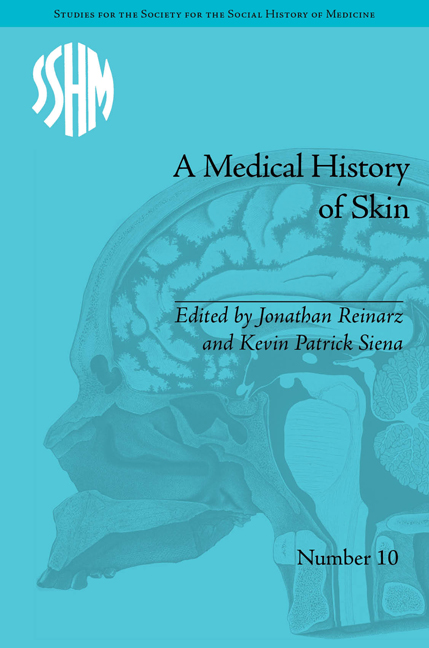Book contents
- Frontmatter
- CONTENTS
- List of Contributors
- List of Figures and Tables
- Scratching the Surface: An Introduction
- Part I The Emerging Skin Field
- Part II Skin, Stigma and Identity
- Part III Skin, Disease and Visual Culture
- 9 ‘An Alteration in the Human Countenance’: Inoculation, Vaccination and the Face of Smallpox in the Age of Jenner
- 10 Portraying Skin Disease: Robert Carswell's Dermatological Watercolours
- 11 Atavistic Marks and Risky Practices: The Tattoo in Medico-Legal Debate, 1850–1950
- 12 ‘Kissed by the Sun’: Tanning the Skin of the Sick with Light Therapeutics, c. 1890–1930
- 13 ‘Classic, Characteristic or Typical’: The Skin and the Visual Properties of External Anthrax Lesions
- Afterword: Reading the Skin, Discerning the Landscape: A Geo-historical Perspective of our Human Surface
- Notes
- Index
10 - Portraying Skin Disease: Robert Carswell's Dermatological Watercolours
from Part III - Skin, Disease and Visual Culture
- Frontmatter
- CONTENTS
- List of Contributors
- List of Figures and Tables
- Scratching the Surface: An Introduction
- Part I The Emerging Skin Field
- Part II Skin, Stigma and Identity
- Part III Skin, Disease and Visual Culture
- 9 ‘An Alteration in the Human Countenance’: Inoculation, Vaccination and the Face of Smallpox in the Age of Jenner
- 10 Portraying Skin Disease: Robert Carswell's Dermatological Watercolours
- 11 Atavistic Marks and Risky Practices: The Tattoo in Medico-Legal Debate, 1850–1950
- 12 ‘Kissed by the Sun’: Tanning the Skin of the Sick with Light Therapeutics, c. 1890–1930
- 13 ‘Classic, Characteristic or Typical’: The Skin and the Visual Properties of External Anthrax Lesions
- Afterword: Reading the Skin, Discerning the Landscape: A Geo-historical Perspective of our Human Surface
- Notes
- Index
Summary
One of the more remarkable nineteenth-century images of a pathological condition represents a woman reclining in a half-upright position, supported by pillows and covered in white clothes and a sheet (see Figure 10.1). When we focus on the upper left section of the watercolour, she seems quite comfortable in her bed despite her very visible skin condition. Her emotionless face does not betray signs of pain or itching; as her eyes do not engage with the viewer, she seems absent and self-contained. The draughtsman, on the other hand, must have looked attentively at his object of study. The question is of where exactly this particular draughtsman, Robert Carswell, a Scottish pathologist studying morbid phenomena in Paris, directed his attention, and what precisely was the object of his study: a sick person or the visual manifestations of smallpox?
What the image confronts us with is a face covered with pustules – an uneven pattern of rash in white colour spread over a reddish ground, suggesting inflamed skin. A scarf wound around the head frames the face, laying bare the symptoms. But this garment is not merely a means of directing focus on the skin disease: a curl escapes from underneath the hair-dress, forming an apparently superfluous but healthy decorous element. Furthermore the draughtsman spared no effort, giving the scarf a stripy pattern and carefully rendering the knot with which it is bound. The inclusion of such figurative elements that distract from the focus of a medical illustration can be explained in various ways.
- Type
- Chapter
- Information
- A Medical History of SkinScratching the Surface, pp. 147 - 164Publisher: Pickering & ChattoFirst published in: 2014



